Aleutia Relia Industrial PC Review: Ivy Bridge & Q77 in a Fanless Chassis
by Ganesh T S on December 4, 2012 10:00 AM EST- Posted in
- Industrial PC
- HTPC
- Ivy Bridge
- Aleutia
Performance Metrics:
In our HTPC reviews, we devote a section to general performance metrics and multiple sections to various HTPC aspects. The Aleutia Relia review unit's Core i7-3770T has the HD4000 GPU inside, and its HTPC performance with respect to rendering and decoding is well known. For this review, we will have a section devoted to performance metrics at room temperature (72 F) and just one additional section for the HTPC aspects (given the target market for the system).
Windows Experience Index and SSD Performance
This metric is often considered meaningless, but we feel it serves as an indicator of what could be the bottleneck in the system. Surprisingly, it was not the HD4000 GPU, but the primary hard disk (Crucial 128 GB mSATA SSD) which initially gave a score of 5.9 to the system.

The Crucial mSATA SSD is supposed to deliver much better performance (since it is based on a comparatively higher end Marvell controller, unlike the cheaper mSATA SSDs based on Phison). To make sure that the SSD was performing to its full potential, we created a partition on the SSD and ran our 4-corner IOMeter benchmark.
| IOMeter Performance | |
| Test | Transfer Rate (MBps) |
| 4 KB Random Write | 125.90 |
| 4 KB Random Read | 60.49 |
| 128 KB Sequential Read | 218.68 |
| 128 KB Sequential Write | 154.18 |
These figures are certainly not bad enough to give a score of 5.9 in the Windows Experience Index. A quick check revealed that the Intel Rapid Storage Technology driver hadn't been installed in the first run. After installation, the score for the primary drive moved on to 7.8, and the system score, as expected, was pulled down by the HD4000 GPU to 6.6.

Futuremark Benchmarks
We pit the Aleutia Relia against other low power industrial / enterprise PCs that have been reviewed on our site earlier.
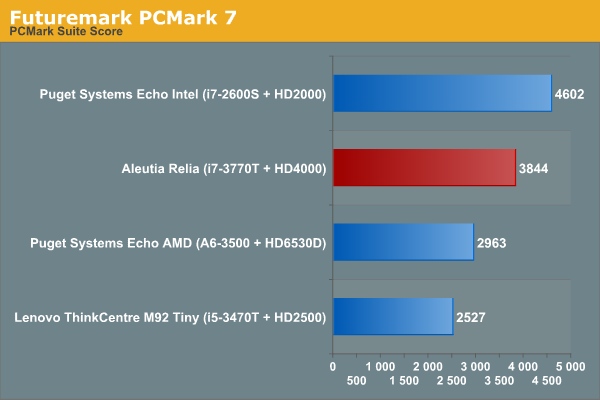
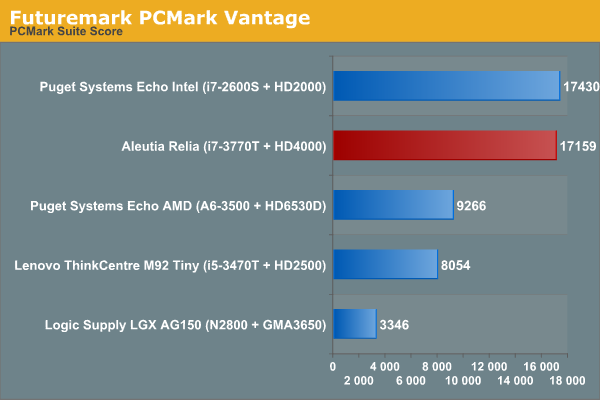
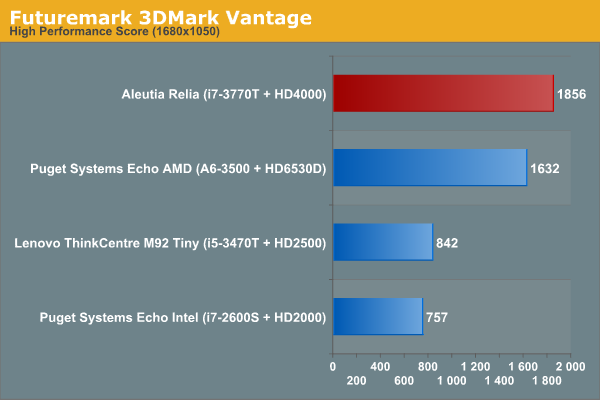

The Aleutia Relia performs consistently well, thanks to its SSD and upgraded HD4000 GPU. It loses out to the i7-2600S based Puget Systems Echo in some benchmarks, but that is because the i7-3770T is a 45W TDP CPU running at 2.5 GHz in comparison to the i7-2600S which is a 65W TDP CPU running at 2.8 GHz.
Miscellaneous Benchmarks
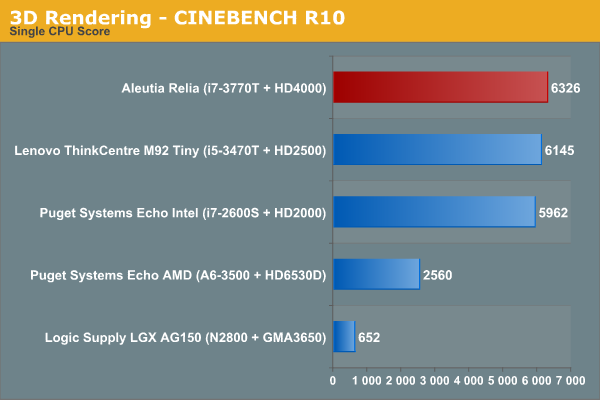
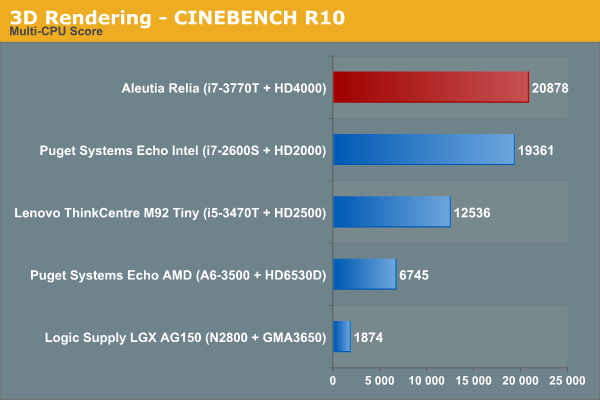
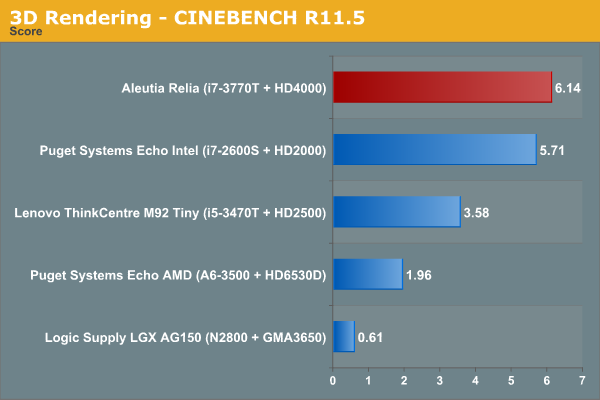
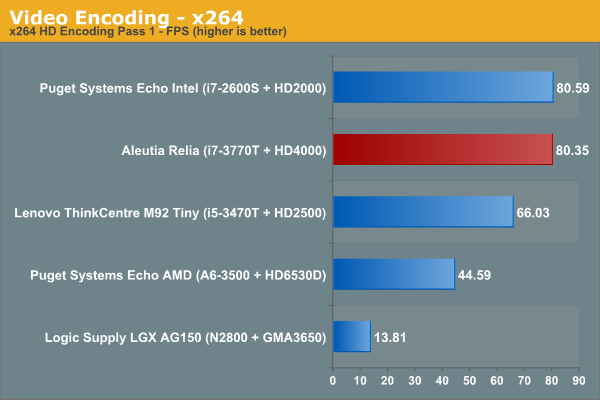
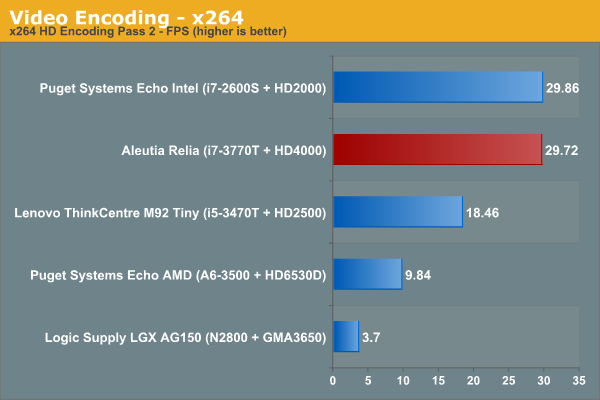
Ivy Bridge brings us strong single-threaded performance and the Aleutia Relia is impressive enough. As more cores are brought into the picture and the CPU loads up, throttling sets in and causes a drop in performance (not quite visible in the above benchmarks, but quite obvious when the FPS figures for each x264 run are observed - ranging from 86 fps in the first run to less than 70 fps in the fourth). That said, the i7-3770T should be adequate for most industrial PC tasks.
An estimate of how well WinRAR performs, particularly with respect to processing split archives, wraps up this section. To evaluate this, we take a 4.36 GB MKV file, compress it in the 'Best' compression mode into a split archive (97.1 MB each), which results in 44 files on the hard disk. The time taken to decompress this split archive is then recorded. The performance in this benchmark is heavily influenced by the disk in the system. For comparison, we use our HTPC review systems. In order to get an idea of how the disk influences the results, we repeated the run with the source and destination being the SSD as well as the HDD.
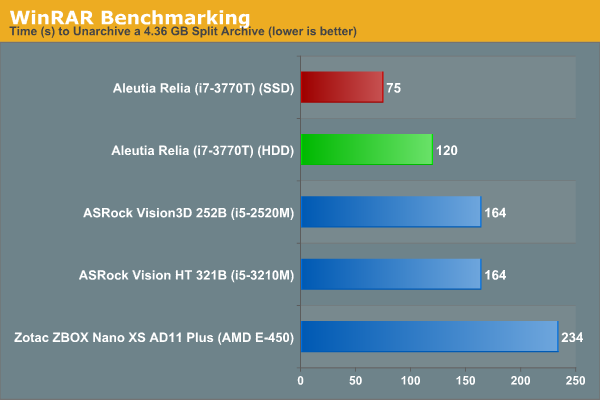










47 Comments
View All Comments
Sikku - Wednesday, December 5, 2012 - link
http://www.mini-box.com/DC-DCganeshts - Wednesday, December 5, 2012 - link
The DQ77KB mITX board has a DC input (mentioned in the review). So, only a AC - DC adapter is needed and no explicit PSU.We have the Streacom Nano150 in-house for use in our upcoming HTPC testbed. It looks very similar to the pico PSU that you have linked below.
Sikku - Wednesday, December 5, 2012 - link
Ok.. Waiting for that review.. :)Hood6558 - Wednesday, December 5, 2012 - link
I don't get it, what's the point of buying a fast CPU installed in a case that takes it to max temp in 3 minutes under any kind of load, and then throttles it back to a lousy 900 MHz? This is "industrial" design? I wonder how long the CPU actually survives under that kind of stress. My guess is a lot of heat-related failures are in the near future of anyone foolish enough to buy one of these somewhat expensive doorstops.ganeshts - Thursday, December 6, 2012 - link
It really depends on the workloads. I doubt users purchasing this unit are going to run Prime 95 + Furmark as their daily workload 24 x 7.Rollo Thomasi - Thursday, December 6, 2012 - link
But then what is the point of an i7 if you are not going to use it?Why not go for a cheaper cooler running CPU?
The only point would be if you have a need to do a lot of short intensive bursts Wright? Then the CPU could work at top speed without throtteling.
Notmyusualid - Thursday, December 6, 2012 - link
And I shall buy one to make a bad-ass wifi AP & caching server (when I get the time).Lowest-end i3, an old SSD,and Squid running on some linux distro, and that should do the trick I reckon. I also have a 3x3 MIMO Card lying around so would likely install a 3rd antenna.
With my ISP now 100M/10M, I've been reluctant to try this without dual GigE ports, and a completely passive cooling solution, AND without looking like an eye sore in the living room.
But the price man...